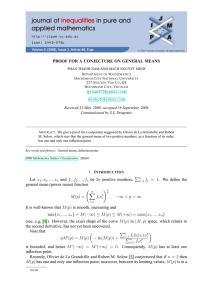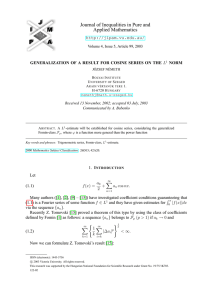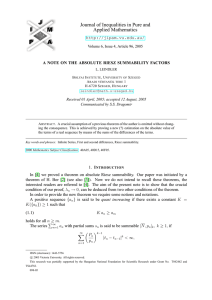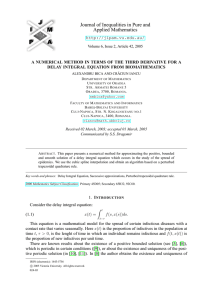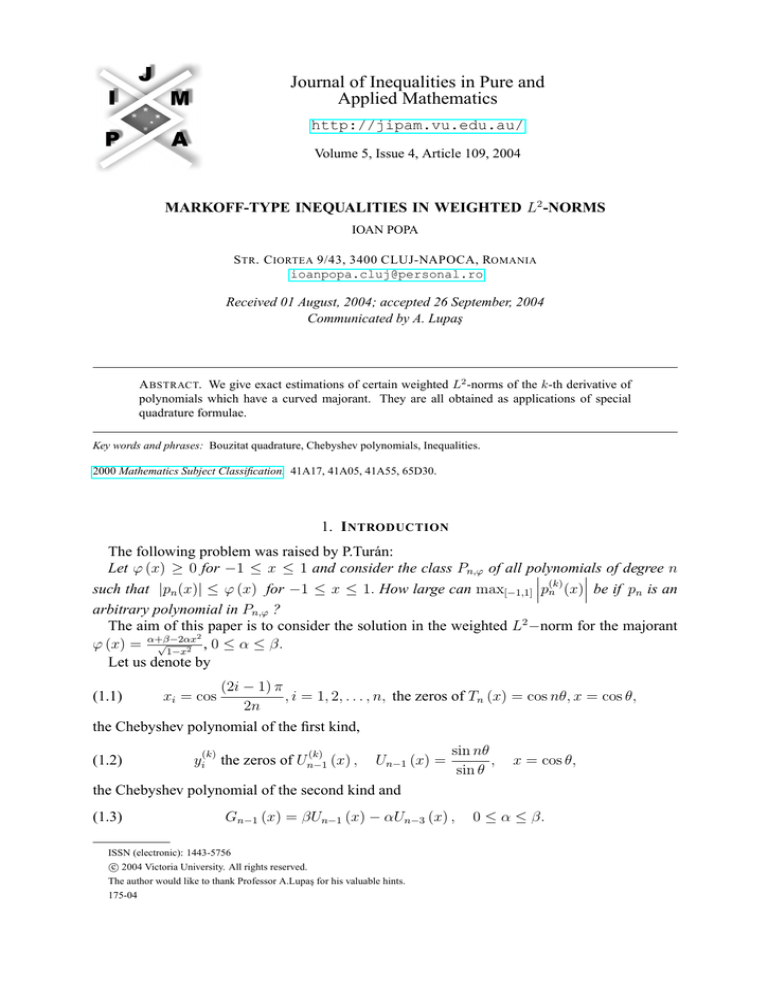
Journal of Inequalities in Pure and
Applied Mathematics
http://jipam.vu.edu.au/
Volume 5, Issue 4, Article 109, 2004
MARKOFF-TYPE INEQUALITIES IN WEIGHTED L2 -NORMS
IOAN POPA
S TR . C IORTEA 9/43, 3400 CLUJ-NAPOCA, ROMANIA
ioanpopa.cluj@personal.ro
Received 01 August, 2004; accepted 26 September, 2004
Communicated by A. Lupaş
A BSTRACT. We give exact estimations of certain weighted L2 -norms of the k-th derivative of
polynomials which have a curved majorant. They are all obtained as applications of special
quadrature formulae.
Key words and phrases: Bouzitat quadrature, Chebyshev polynomials, Inequalities.
2000 Mathematics Subject Classification. 41A17, 41A05, 41A55, 65D30.
1. I NTRODUCTION
The following problem was raised by P.Turán:
Let ϕ (x) ≥ 0 for −1 ≤ x ≤ 1 and consider the class Pn,ϕ of all polynomials
of degree n
(k) such that |pn (x)| ≤ ϕ (x) for −1 ≤ x ≤ 1. How large can max[−1,1] pn (x) be if pn is an
arbitrary polynomial in Pn,ϕ ?
The aim of this paper is to consider the solution in the weighted L2 −norm for the majorant
2
√
ϕ (x) = α+β−2αx
, 0 ≤ α ≤ β.
1−x2
Let us denote by
(2i − 1) π
, i = 1, 2, . . . , n, the zeros of Tn (x) = cos nθ, x = cos θ,
2n
the Chebyshev polynomial of the first kind,
(1.1)
(1.2)
xi = cos
(k)
yi
(k)
the zeros of Un−1 (x) ,
Un−1 (x) =
sin nθ
,
sin θ
x = cos θ,
the Chebyshev polynomial of the second kind and
(1.3)
Gn−1 (x) = βUn−1 (x) − αUn−3 (x) ,
ISSN (electronic): 1443-5756
c 2004 Victoria University. All rights reserved.
The author would like to thank Professor A.Lupaş for his valuable hints.
175-04
0 ≤ α ≤ β.
2
I OAN P OPA
Let Hα,β be the class of all real polynomials pn−1 , of degree ≤ n − 1 such that
α + β − 2αx2i
p
,
1 − x2i
where the xi ’s are given by (1.1) and 0 ≤ α ≤ β.
(1.4)
|pn−1 (xi )| ≤
i = 1, 2, . . . , n,
2. R ESULTS
Theorem 2.1. If pn−1 ∈ Hα,β then we have
Z 1
0
2
1
√
(2.1)
pn−1 (x) dx
1 − x2
−1
2π (n − 1) ≤
(α − β)2 n (n + 1) (n − 2) (n − 3)
15
+ 5 (n − 1) β 2 n (n + 1) − α2 (n − 2) (n − 3)
with equality for pn−1 = Gn−1.
Two cases are of special interest:
√
I. Case α = β = 12 , ϕ (x) = 1 − x2 (circular majorant), Gn−1 = Tn−1 .
Note that Pn−1,ϕ ⊂ H 1 , 1 , Tn−1 ∈
/ Pn−1,ϕ , Tn−1 ∈ H 1 , 1 .
2 2
2 2
Corollary 2.2. If pn−1 ∈ H 1 , 1 then we have
2 2
Z 1
0
2
1
√
(2.2)
pn−1 (x) dx ≤ π (n − 1)3 ,
1 − x2
−1
with equality for pn−1 = Tn−1 .
1
II. Case α = 0, β = 1, ϕ (x) = √1−x
2 , Gn−1 = Un−1 .
Note that Pn−1,ϕ ⊂ H0,1 , Un−1 ∈ Pn−1,ϕ , Un−1 ∈ H0,1 .
Corollary 2.3. If pn−1 ∈ H0,1 then we have
Z 1
0
2
2πn (n4 − 1)
1
√
pn−1 (x) dx ≤
,
(2.3)
15
1 − x2
−1
with equality for pn−1 = Un−1 .
In this second case we have a more general result:
Theorem 2.4. If pn−1 ∈ H0,1 and
r (x) = b (b − 2a) x2 + 2c (b − a) x + a2 + c2
with 0 < a < b, |c| < b − a, b 6= 2a then we have
Z 1
i2
k−1/2 h (k+1)
(2.4)
r (x) 1 − x2
pn−1 (x) dx
−1
"
#
2
π (n + k + 1)! [2 (n2 − k 2 ) − 3 (2k + 1)] (a − b) + c2
a2 + c 2
≤
+
,
(n − k − 2)!
(2k + 1) (2k + 3) (2k + 5)
2k + 3
where k = 0, . . . , n − 2 , with equality for pn−1 = Un−1.
Setting a = 1, b = c = 0 one obtains the following
J. Inequal. Pure and Appl. Math., 5(4) Art. 109, 2004
http://jipam.vu.edu.au/
M ARKOFF - TYPE I NEQUALITIES
3
Corollary 2.5. If pn−1 ∈ H0,1 then we have
Z 1
i2
k−1/2 h (k+1)
2π (n + k + 1)!
n2 + k 2 + 3k + 1
(2.5)
1 − x2
pn−1 (x) dx ≤
,
(n − k − 2)! (2k + 1) (2k + 3) (2k + 5)
−1
k = 0, . . . , n − 2 , with equality for pn−1 = Un−1.
3. L EMMAS
Here we state and prove some lemmas which help us in proving the above theorems.
2
α+β−2αx
Lemma 3.1. Let pn−1 be such that |pn−1 (xi )| ≤ √ 2 i , i = 1, 2, . . . , n, where the xi ’s are
1−xi
given by (1.1). Then we have
0
pn−1 (yj ) ≤ G0n−1 (yj ) ,
(3.1)
k = 0, 1, . . . , n − 1,
and
0
pn−1 (1) ≤ G0n−1 (1) ,
(3.2)
0
pn−1 (−1) ≤ G0n−1 (−1) .
Proof. By the Lagrange interpolation formula based on the zeros of Tn and using Tn0 (xi ) =
(−1)i+1 n
1/2 , we can represent any algebraic polynomial pn−1 by
(1−x2i )
n
1/2
1 X Tn (x)
pn−1 (x) =
(−1)i+1 1 − x2i
pn−1 (xi ) .
n i=1 x − xi
From
Gn−1 (xi ) = (−1)i+1
we have
α + β − 2αx2i
p
1 − x2i
n
1 X Tn (x)
α + β − 2αx2i .
Gn−1 (x) =
n i=1 x − xi
Differentiating with respect to x we obtain
n
p0n−1
1/2
1 X Tn0 (x) (x − xi ) − Tn (x)
(x) =
(−1)i+1 1 − x2i
pn−1 (xi ) .
2
n i=1
(x − xi )
On the roots of Tn0 (x) = nUn−1 (x) and using (1.4) we find
n
X
0
|Tn (yj )|
2
pn−1 (yj ) ≤ 1
2 α + β − 2αxi
n i=1 (yj − xi )
=
For li (x) =
Tn (x)
x−xi
n
|Tn (yj )| X α + β − 2αx2i
= G0n−1 (yj ) .
2
n
(yj − xi )
i=1
taking into account that li0 (1) > 0 (see [6]) it follows that
n
X
0
pn−1 (1) ≤ 1
li0 (1) α + β − 2αx2i = G0n−1 (1) .
n i=1
Similarly p0n−1 (−1) ≤ G0n−1 (−1) .
We shall need the result of Duffin and Schaeffer [2]:
J. Inequal. Pure and Appl. Math., 5(4) Art. 109, 2004
http://jipam.vu.edu.au/
4
I OAN P OPA
n
Q
Lemma 3.2 (Duffin – Schaeffer). If q (x) = c
distinct real zeros and if p ∈ Pn is such that
(x − xi ) is a polynomial of degree n with n
i=1
|p0 (xi )| ≤ |q 0 (xi )|
(i = 1, 2, . . . , n) ,
then for k = 1, 2, . . . , n − 1,
(k+1) (k+1) p
(x) ≤ q
(x)
whenever q (k) (x) = 0.
Lemma 3.3. Let pn−1 be such that |pn−1 (xi )| ≤ √ 1
1−x2i
given by (1.1). Then we have
(k+1) (k) (k+1) (k) (3.3)
pn−1 (yj ) ≤ Un−1 (yj ) ,
, i = 1, 2, . . . , n, where the xi ’s are
(k)
(k)
whenever Un−1 (yj ) = 0,
for k = 0, 1, . . . , n − 1, and
(k+1) (k+1) (k+1)
(k+1)
(3.4)
pn−1 (1) ≤ Un−1 (1) , pn−1 (−1) ≤ Un−1 (−1) .
0
Proof. For α = 0, β = 1, Gn−1 = Un−1 and (3.1) give p0n−1 (yj ) ≤ Un−1
(yj )
and (3.2)
0
0
0
pn−1 (1) ≤ Un−1
(−1) .
(1) , p0n−1 (−1) ≤ Un−1
Now the proof is concluded by applying the Duffin-Schaeffer lemma.
The following proposition was proved in [3].
Lemma 3.4. A real polynomial r of exact degree 2 satisfies r (x) > 0 for −1 ≤ x ≤ 1 if and
only if
r (x) = b (b − 2a) x2 + 2c (b − a) x + a2 + c2
with 0 < a < b, |c| < b − a, b 6= 2a.
We need the following quadrature formulae:
(k)
Lemma 3.5. For any given n and k, 0 ≤ k ≤ n − 1, let yi , i = 1, . . . , n − k − 1, be the zeros
(k)
of Un−1 . Then the quadrature formulae
1
Z
1−x
(3.5)
2 k−1/2
f (x) dx = A0 [f (−1) + f (1)] +
n−k−1
X
−1
(k)
,
si f y i
i=1
where
A0 =
22k−1 (2k + 1) Γ (k + 1/2)2 (n − k − 1)!
,
(n + k)!
si > 0
and
Z
1
(3.6)
1 − x2
k−1/2
f (x) dx
−1
0
0
= B0 [f (−1) + f (1)] + C0 [f (−1) − f (1)] +
n−k−2
X
(k+1)
vi f yi
,
i=1
J. Inequal. Pure and Appl. Math., 5(4) Art. 109, 2004
http://jipam.vu.edu.au/
M ARKOFF - TYPE I NEQUALITIES
5
where
22k (2k + 3) Γ (k + 3/2)2 (n − k − 2)!
,
(n + k + 1)!
2 n2 − (k + 2)2 (2k + 3) + 4 (k + 1) (2k + 5)
B0 = C0
(2k + 1) (2k + 5)
have algebraic degree of precision 2n − 2k − 1.
The quadrature formulae
Z 1
n−k−1
X
(k)
(k)
2 k−1/2
(3.7)
f yi
,
r (x) 1 − x
f (x) dx = A1 f (−1) + B1 f (1) +
si r y i
C0 =
−1
i=1
where
A1 =
22k−1 (2k + 1) Γ (k + 1/2)2 (n − k − 1)! (a − b + c)2
,
(n + k)!
22k−1 (2k + 1) Γ (k + 1/2)2 (n − k − 1)! (a − b − c)2
B1 =
(n + k)!
and
Z
1
(3.8)
r (x) 1 − x2
k−1/2
f (x) dx = C1 f (−1) + D1 f (1)
−1
0
0
+ C2 f (−1) − D2 f (1) +
n−k−2
X
vi r
(k+1)
yi
(k+1)
f yi
,
i=1
C1 = B0 (a − b + c)2 + 2C0 d, D1 = B0 (a − b − c)2 − 2C0 e,
C2 = C0 (a − b + c)2 , D2 = C0 (a − b − c)2 ,
d = 2ab + bc − ac − b2 , e = b2 − 2ab + bc − ac.
have algebraic degree of precision 2n − 2k − 3.
Proof. In order to compute the coefficients we need the following formulae
Z 1
(1 − x)α (1 + x)λ Pm(α,β) (x) dx
−1
(−1)m 2α+λ+1 Γ (λ + 1) Γ (m + α + 1) Γ (β − λ + m)
=
,
Γ (m + 1) Γ (β − λ) Γ (m + α + λ + 2)
(3.9)
Z
λ < β.
1
(1 − x)λ (1 + x)β Pm(α,β) (x) dx
−1
2β+λ+1 Γ (λ + 1) Γ (m + β + 1) Γ (α − λ + m)
, λ<α
Γ (m + 1) Γ (α − λ) Γ (m + β + λ + 2)
The first quadrature formula (3.5) is the Bouzitat formula of the second kind [4, formula (4.8.1)],
(k+ 21 ,k+ 12 )
(k)
. Setting α = β = 12 , m = n − k − 1 in [4, formula (4.8.5)]
for the zeros of Un−1 = cPn−k−1
we find A0 and si > 0 (cf. [4, formula (4.8.4)]).
If in the above quadrature formula (3.6), taking into account (3.9), we put
(k+ 23 ,k+ 32 )
(x) ,
f (x) = (1 − x) (1 + x)2 Pn−k−2
=
(k+ 32 ,k+ 32 )
(k+1)
(x) ,
Un−1 (x) = cPn−k−2
J. Inequal. Pure and Appl. Math., 5(4) Art. 109, 2004
http://jipam.vu.edu.au/
6
I OAN P OPA
we obtain C0 , and for
(k+ 32 ,k+ 32 )
f (x) = (1 + x)2 Pn−k−2
(x)
we find B0 .
If in formula (3.5) we replace f (x) with r (x) f (x) we get (3.7) and if in formula (3.6) we
replace f (x) with r (x) f (x) we get (3.8).
4. P ROOF OF THE T HEOREMS
Proof of Theorem 2.1. Setting k = 0 in (3.5) we find the formula
Z
1
−1
n−1
π
πX
f (x)
√
dx =
[f (−1) + f (1)] +
f (yi ) .
2n
n i=1
1 − x2
According to this quadrature formula and using (3.1) and (3.2) we have
1
Z
−1
n−1
2
2 π X
2
0
2
π 0
1
π 0
√
p0n−1 (yi )
pn−1 (x) dx =
pn−1 (−1) +
pn−1 (1) +
2n
2n
n i=1
1 − x2
n−1
2
2 π X
2
π
π
G0n−1 (−1) +
G0n−1 (1) +
G0n−1 (yi )
2n
2n
n i=1
Z 1
0
2
1
√
=
Gn−1 (x) dx.
1 − x2
−1
≤
Now
Z
1
−1
0
2
2
Z 1 0
Gn−1 (x)
U
(x)
√n−1
√
dx
dx = β 2
1 − x2
1 − x2
−1
2
Z 1 0
Z 1 0
0
Un−3 (x)
Un−1 (x) Un−3
(x)
2
√
√
− 2αβ
dx + α
dx.
1 − x2
1 − x2
−1
−1
Using the following formula (k = 0 in (3.6))
Z
1
−1
f (x)
3π (3n2 − 2)
√
dx =
[f (−1) + f (1)]
10n (n2 − 1)
1 − x2
n−2
X
3π
0
0
+
[f
(−1)
−
f
(1)]
+
ci f (yi0 )
4n (n2 − 1)
i=1
we find
0
2
Un−1 (x)
2πn (n4 − 1)
√
=
,
15
1 − x2
−1
0
0
Un−1
(x) Un−3
(x)
2πn (n2 − 1) (n − 2) (n − 3)
√
=
,
15
1 − x2
Z
Z
1
−1
Z
1
−1
1
0
2
Un−3 (x)
2π (n − 1) (n2 − 4n + 5) (n − 2) (n − 3)
√
=
15
1 − x2
J. Inequal. Pure and Appl. Math., 5(4) Art. 109, 2004
http://jipam.vu.edu.au/
M ARKOFF - TYPE I NEQUALITIES
and
Z
1
−1
7
0
2
Gn−1 (x)
2π (n − 1) √
dx =
(α − β)2 n (n + 1) (n − 2) (n − 3)
2
15
1−x
+ 5 (n − 1) β 2 n (n + 1) − α2 (n − 2) (n − 3) .
Proof of Theorem 2.4. According to the quadrature formula (3.7), positivity of si ’s, and using
(3.3) and (3.4) we have
Z 1
h
i2
(k+1)
2 k−1/2
r (x) 1 − x
pn−1 (x) dx
−1
= A1
h
≤ A1
h
(k+1)
pn−1
i2
h
i2 n−k−1
h
i2
X
(k+1)
(k)
(k+1)
(k)
(−1) + B1 pn−1 (1) +
si r y i
pn−1 yi
i=1
i2
h
i2 n−k−1
h
i2
X
(k+1)
(k+1)
(k)
(k+1)
(k)
Un−1 (−1) + B1 Un−1 (1) +
si r y i
Un−1 yi
i=1
Z
1
=
r (x) 1 − x2
k−1/2
h
i2
(k+1)
Un−1 (x) dx.
−1
h
(k+1)
Un−1
i2
(x) .
In order to complete the proof we apply formula (3.8) to f =
(k+1)
(k+1)
= 0 and the following relations deduced from [1]
Having in mind Un−1 yi
2
2
2
2
n
(n
−
1
)
·
·
·
n
−
(k
+
1)
(k+1)
Un−1 (1) =
,
1 · 3 · · · (2k + 3)
(k+2)
Un−1
n2 − (k + 2)2 (k+1)
(1) =
Un−1 (1) ,
2k + 5
(k+1)
(k+2)
(k+1)
(k+2)
Un−1 (−1) Un−1 (−1) = −Un−1 (1) Un−1 (1) ,
we find
Z 1
r (x) 1 − x2
k−1/2 h
i2
(k+1)
pn−1 (x) dx
−1
h
i2
h
i2
(k+1)
(k+1)
= C1 Un−1 (−1) + D1 Un−1 (1)
(k+1)
(k+2)
(k+1)
(k+2)
+ 2C2 Un−1 (−1) Un−1 (−1) − 2D2 Un−1 (1) Un−1 (1)
"
#
2
π (n + k + 1)! [2 (n2 − k 2 ) − 3 (2k + 1)] (a − b) + c2
a2 + c 2
+
.
=
(n − k − 2)!
(2k + 1) (2k + 3) (2k + 5)
2k + 3
R EFERENCES
[1] D.K. DIMITROV, Markov inequalities for weight functions of Chebyshev type, J. Approx. Theory, 83 (1995), 175–181.
[2] R.J. DUFFIN AND A.C. SCHAEFFER, A refinement of an inequality of the brothers Markoff, Trans.
Amer. Math. Soc., 50 (1941), 517–528.
J. Inequal. Pure and Appl. Math., 5(4) Art. 109, 2004
http://jipam.vu.edu.au/
8
I OAN P OPA
[3] W. GAUTSCHI AND S.E. NOTARIS, Gauss-Kronrod quadrature formulae for weight function of
Bernstein-Szegö type, J. Comput. Appl. Math., 25(2) (1989), 199–224.
[4] A. GHIZZETTI AND A. OSSICINI, Quadrature formulae, Akademie-Verlag, Berlin, 1970.
[5] A. LUPAŞ, Numerical Methods, Constant Verlag, Sibiu, 2001.
[6] R. PIERRE AND Q.I. RAHMAN, On polynomials with curved majorants, in Studies in Pure Mathematics, Budapest, (1983), 543–549.
J. Inequal. Pure and Appl. Math., 5(4) Art. 109, 2004
http://jipam.vu.edu.au/




